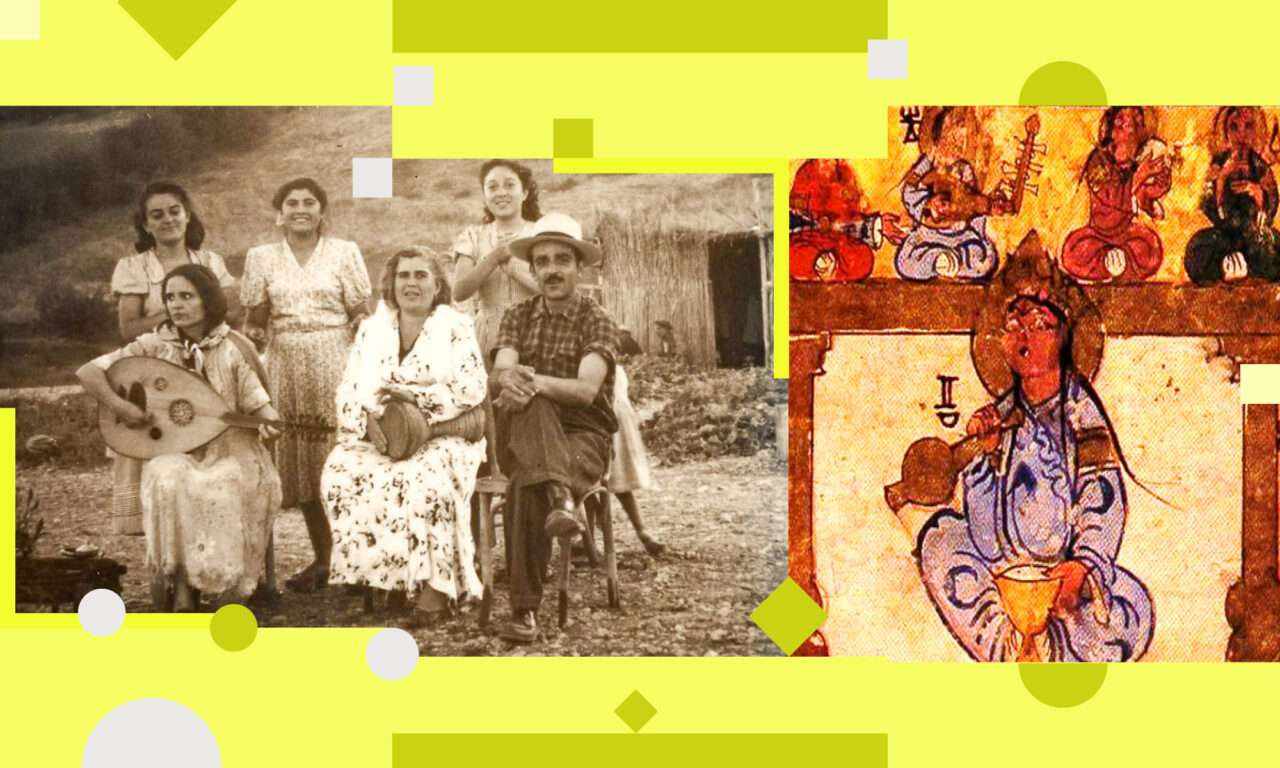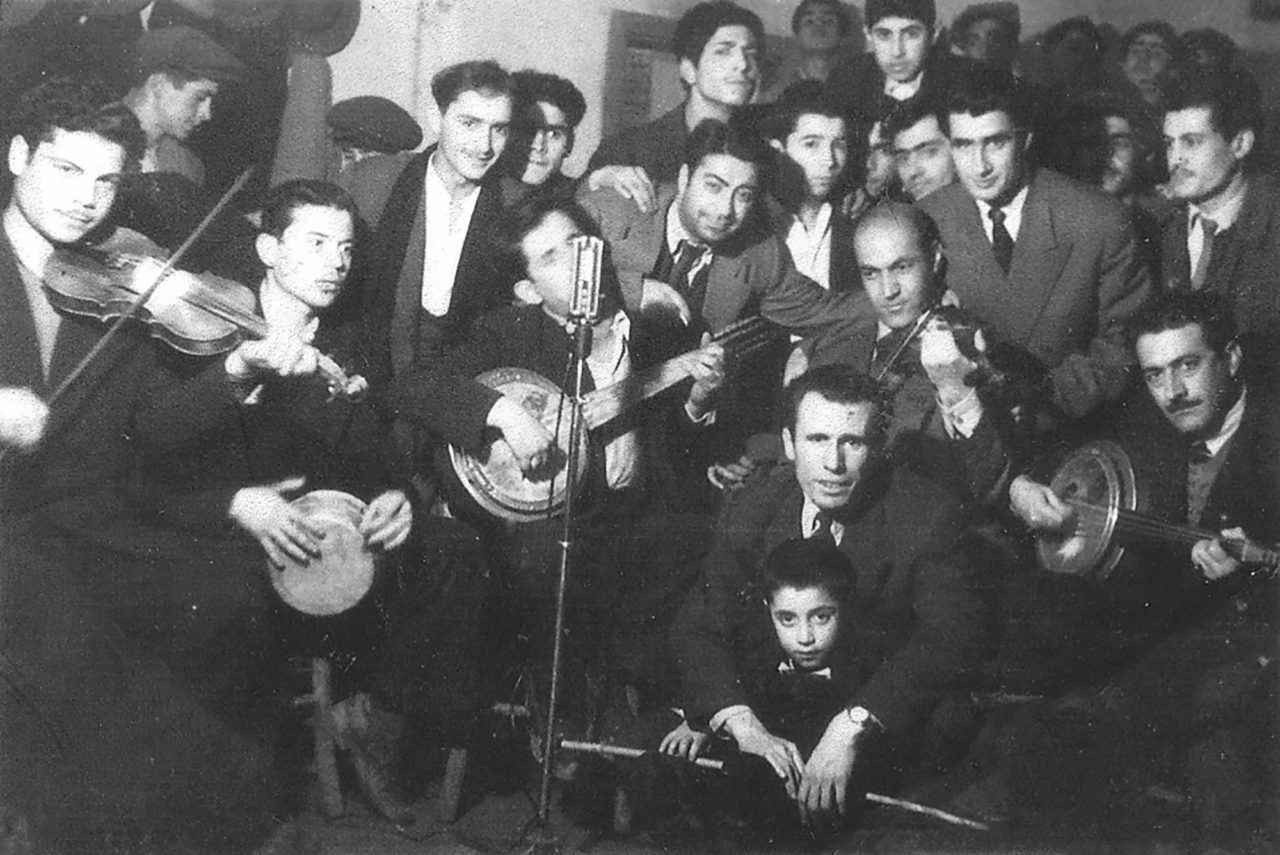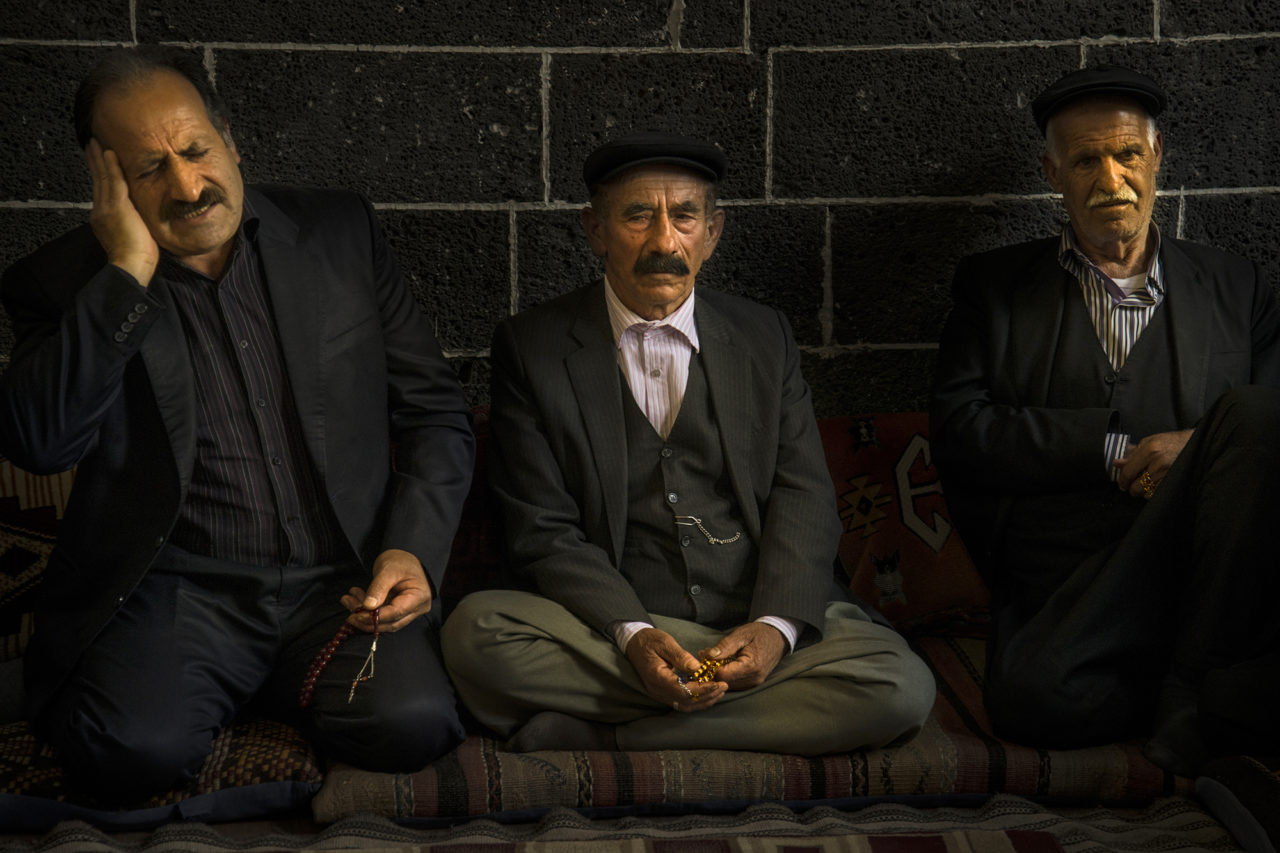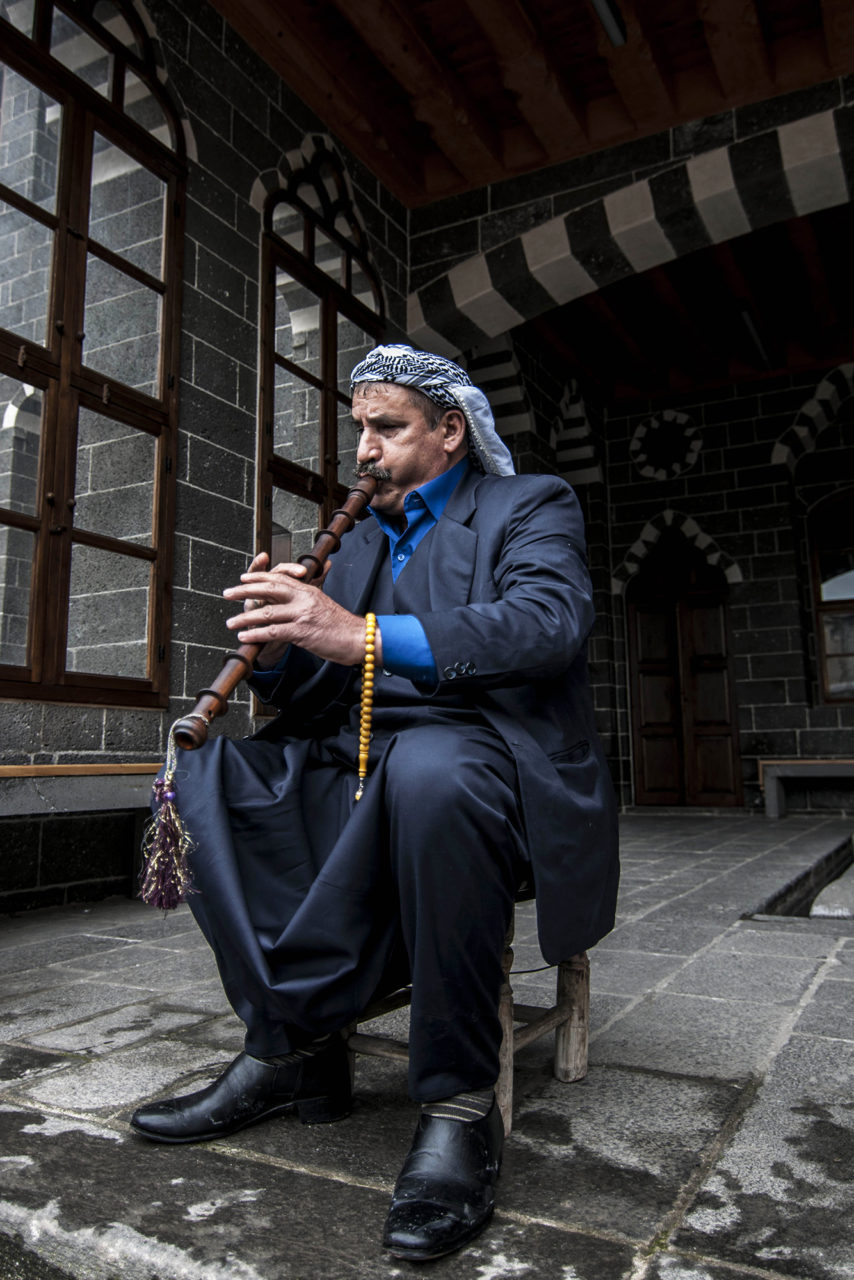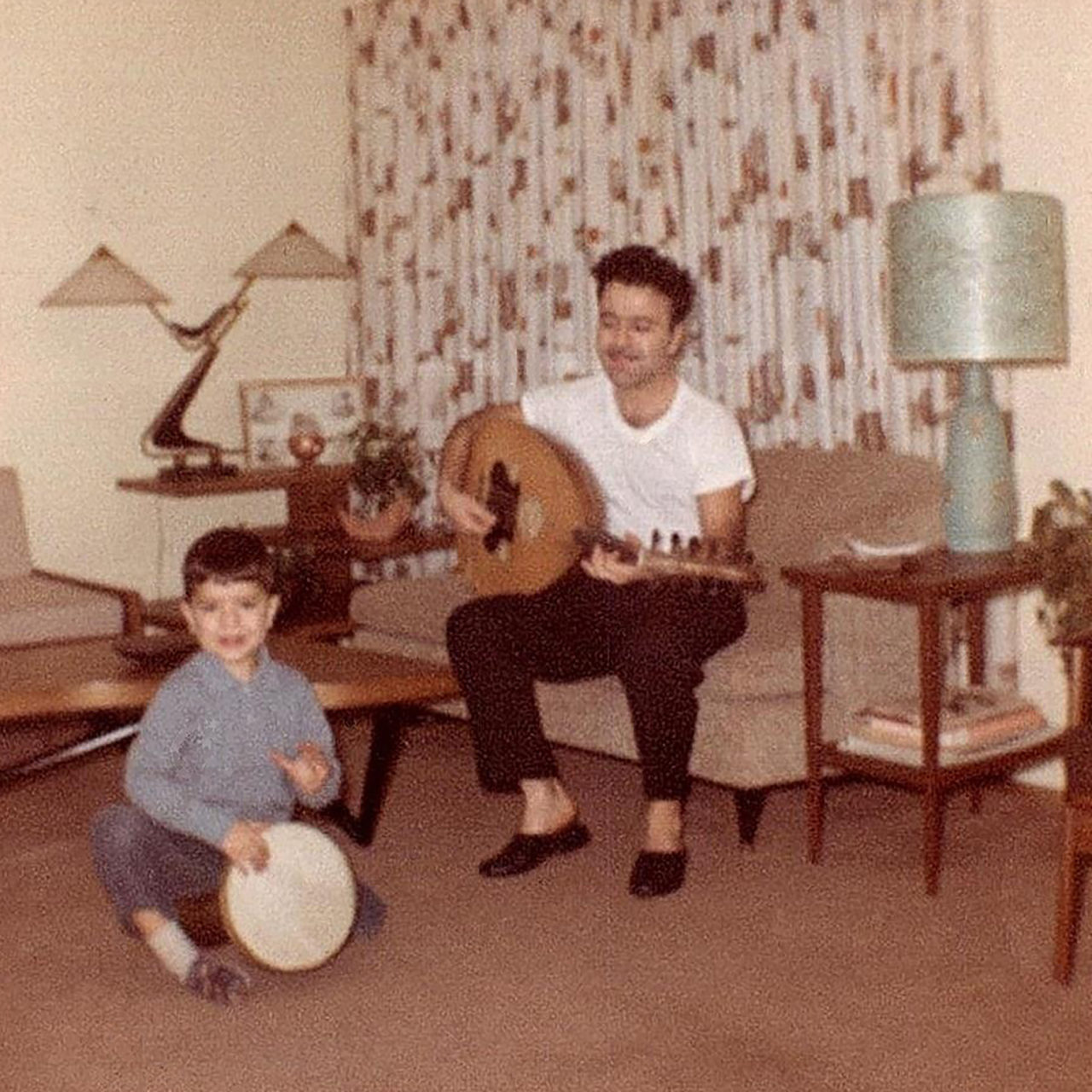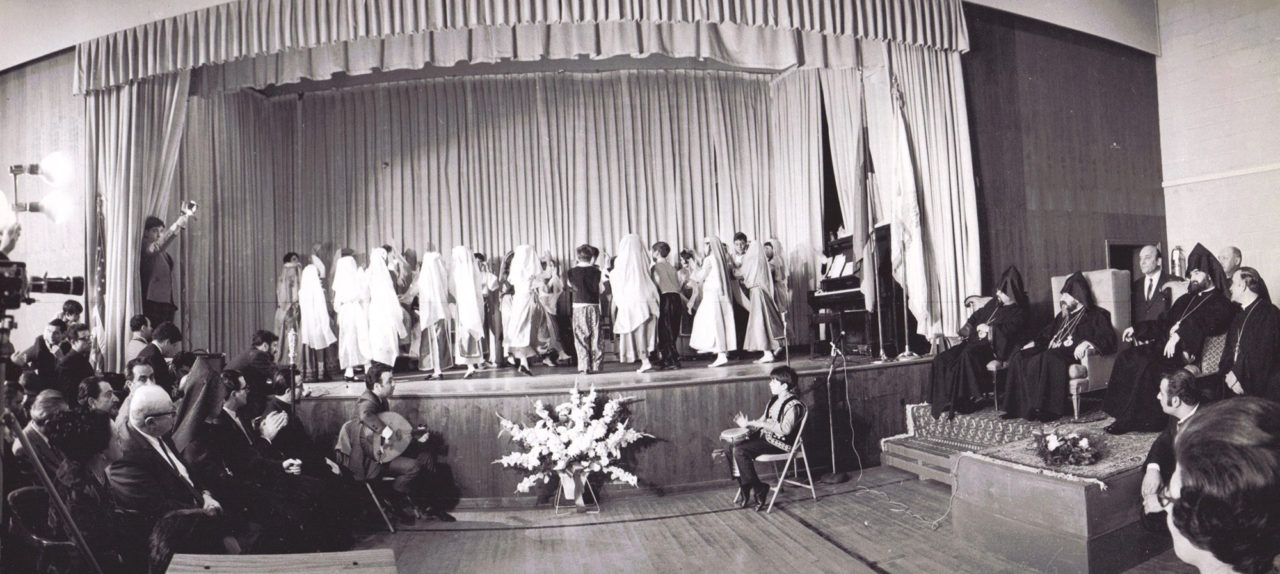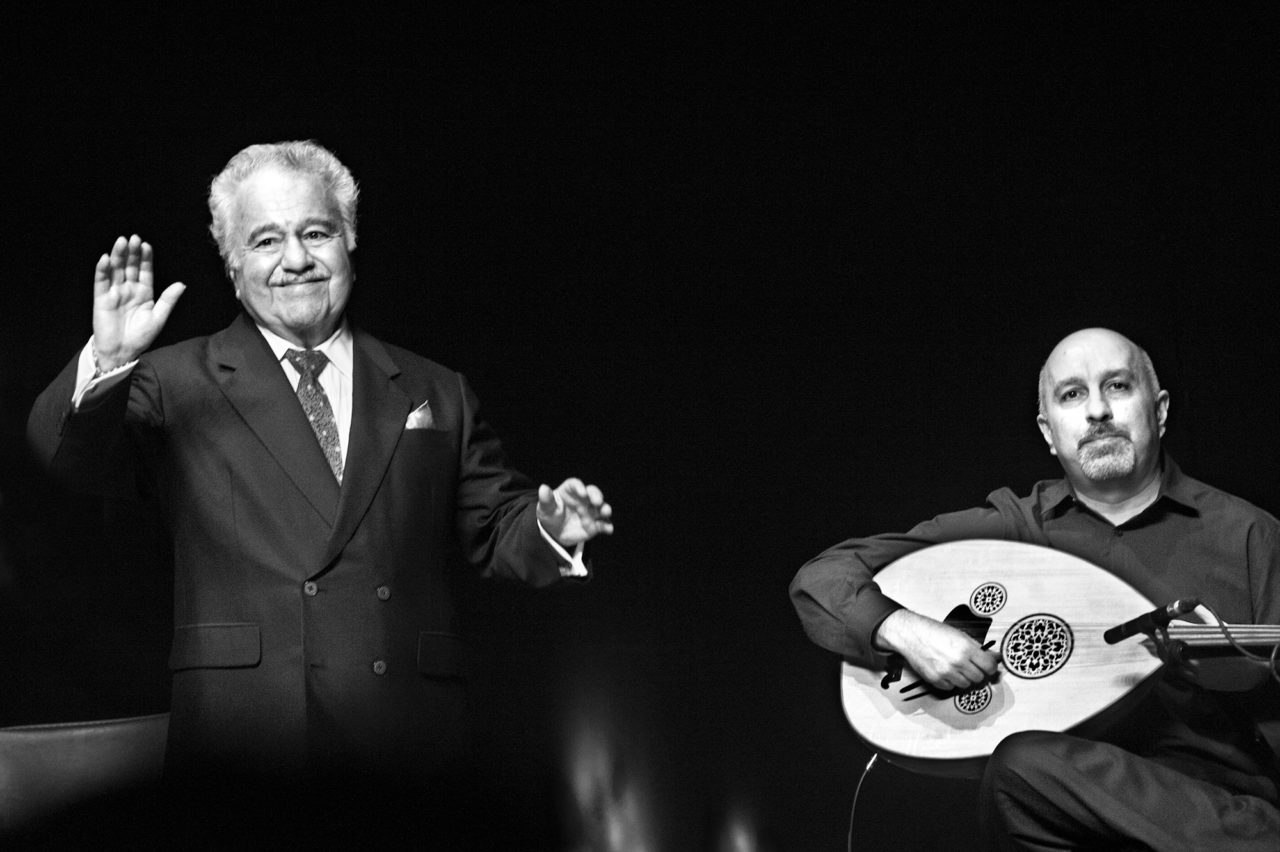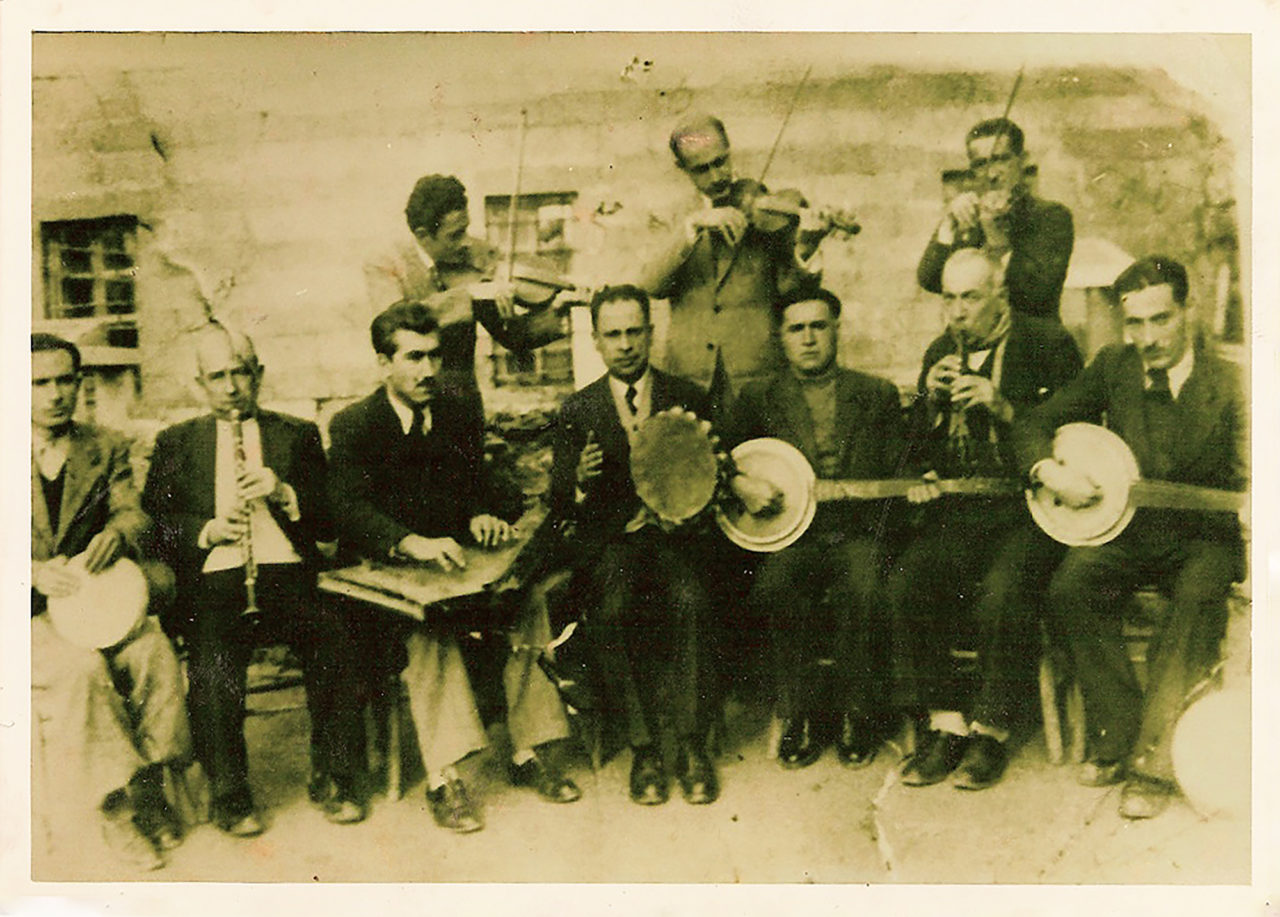
In memory of Seyidxanê Boyaxçî, who sadly passed away during the preparation of this exhibition…
The history of cities like Diyarbakır flows with music as rich as that history. The fundamental, enlightening information on this topic will be provided by local artists and researcher Hayri Yoldaş, who works on Diyarbakır music. The first article written for this section is “Unearthing a ‘buried treasure’: places and times of dengbêjî in Diyarbakır city”. French academic Clémence Scalbert Yücel who works on Kurdish language, literature and culture, focuses on the roots of this tradition and its transformation over time.
Diyarbakır Armenian musician Ara Dinkjian, who was raised in the United States, contributes an article titled “10/8: Diyarbekir Music”¹ where he thinks about homes and the “homeland”; and takes a trip accompanied by the “curcuna” rhythm that brings Armenians, Kurds, Turks and all peoples of these lands together.
¹ We would like to thank Onur Günay for his contributions.
The long history of settlement in Diyarbakır and its environs mean that the tradition of music has equally deep roots. Sources underline the significance of the Artuqid period. After the city became a capital, it is known that musical festivities were held at many Aq Qoyunlu palaces. Musicians were given special protection during the periods of Uzun Hasan, and later his son, Sultan Yaqub, who were known in the 1400s for their general appreciation of science and the arts. In fact, Uzun Hasan was known to take a group of 98 musicians with him on his military campaigns.
This palace-based musical tradition that stands out when Diyarbakır’s relationship with music is examined has also seeped into and influenced the region’s folk music and given it a classical air. In a general framework, the main trajectories of musical development in the region can be treated under the headings of the minstrel/bard tradition, tekke[lodge]-tasavvuf music, classical Turkish music, folk music and the dengbêj tradition.
• Güldoğan, V. (2011) Diyarbakır Kültürü [Diyarbakır Culture], Kripto Yayınları.
• Unat, Y. (2019) El Cezeri [Al-Jazari], Muhayyel Yayınları, İstanbul.
The period from 1600 to 1900 was a period when mostly classical music and religious tekke (lodge) music was performed. The only Turkish folk music work that has survived from 1638 is Ömür (Yaş) Destanı [The Legend of Life], a work in the koşma style. When Sultan Murad IV came to Diyarbakır in 1638 in preparation for his Baghdad campaign, Sheikh Aziz Mahmoud, a notable figure of the city, held a great feast in his honour at his newly-built Çârbağ Mansion in the Kavs resort (the Kavs/Cihannüma Mansion). Here, a musician of the period, Hacı Eftal Efendi, was accepted into the presence of Murad IV. Ömür Destanı was among works performed, and it impressed the sultan to such an extent, it is said that he awarded Hacı Eftal Efendi by redirecting the renowned Hamravat River to his home.
Yaş Destanı (Kırk Yaş) – Celal Güzelses
Other significant musicians of the period included the renowned composer of the Ahmed II era, Ahmet Verdi Çelebi; minstrel Ahü Baba who Murad IV admired so much that he included among his songsters; Molla Çelebi who was a songster of Mehmed IV; Diyarbakır Armenian poet Siruni (Şirin) who has destans, gazels and composed koşmas to his name; Hicazi, renowned for his mastery of chess, history as well as music; Mahmud Çelebi, renowned for around thirty compositions; and the Diyarbakır Armenian poet Civan, who has both gazels and divans written in aruz prosody as well as composed koşmas and mayas.
Works composed after the 1900s were in the ‘sanat müziği’ [art, or artistic music] form, with inspiration from artists of the past. Works that marked the exceptional place of Diyarbakır ‘sanat müziği’ in Turkish folk music would take precedence in the repertoire. Celal Güzelses was highly competent in all maqams and usûls [modes] thanks to the tasavvuf music lessons he took from Hafız Melek Efendi, and was influenced by divan poets and minstrels in his works in the şarkı form. As for those in the türkü form, he sometimes made his own compositions, and also used Kurdish melodic patterns. No work similar to his is produced today anymore. It is also known that Sadettin Kaynak later used in his songs in the Turkish ‘sanat müziği’ form many of the şarkı motifs he closely observed during his military service in Diyarbakır.
Hayri Yoldaş, Local artist, Music researcher
In Diyarbakır music, instruments have changed over time. Çığırtma, an instrument used in the early period, is a type of kaval, made from the wing bone of eagles, with seven holes, six on top and one below. The santur is an instrument similar to the qanun, and is played by hammering with two mallets, and like the saz, bağlama, kaval, zil, maşa and tef (tambourine) is an early period instrument. The zilli tef (tambourine) and darbuka (goblet) joined them at a later date. Folk dances are accompanied by davul (drum) and zurna, today as in the past. “Sazlı santurlu düğün”, or “a wedding with saz and santur” was a phrase used in the past to describe a magnificent wedding.
In the following period, qanun, the violin, oud and cümbüş were joined by the clarinet, adding colour to bands. In the 1970s, Diyarbakır music was introduced to the bağlama. However, since the bağlama’s sound could not reach satisfactory levels in some spaces, the metal tanbur replaced the bağlama, at least until pick-ups became more widely used, since it had a louder volume yet the same fretboard as the bağlama. In fact, for a long time, the bağlama was also referred to as tanbur. Bağlama was more frequently seen in Alevi villages. However, today it is the indispensable instrument of all weddings.
Hayri Yoldaş
Unearthing a “buried treasure”: places and times of dengbêjî in Diyarbakır city
Dengbêjs are Kurdish “singer-poets” or “masters of voice”.¹ The main tool of their art is their voice – as well as their words. Dengbêjs tell stories sung in Kurdish verse, mostly a cappella, though, occasionally accompanied by an instrument. Their stories deal with topics ranging from love, to conflicts, war and battles, and legendary events. Dengbêjs learn their stories (usually referred to as kilam) from older experienced dengbêjs but also create their own kilams thereby always renewing and transforming the repertoire. Dengbejs’ performances are ‘plain’, requiring these 4 components: “a dengbêj, a voice, a story, and a public”.² Performance places used to be weddings or guest houses in villages across Kurdistan. Mainly men would perform in front of an audience, hence mostly men used to be known and recognised as dengbêj, while women would perform in more intimate family circles or groups of fellow women.
With socio-economical changes occurring from the mid-20th century, village life started to undergo profound transformations. Peasants and villagers migrated to neighboring towns and cities. From that time onward, dengbêjs started to settle and perform in the city of Diyarbakır.³ The urban environment became a place of performance, such a move manifested changes in the dengbêj practice.
Bavê Seyro – Seyidxanê Boyaxçî
The examples from the famous dengbêjs of Diyarbakır – whose fame often went well beyond the city – illustrate this change. In his village, Lexerî, Seyidxanê Boyaxçî (1938-2020) did not own any land; in order to make a living, in 1958 aged 20 he moved to Diyarbakır where he worked as a shoe polisher and garbage collector. Huseynê Farê (1939-2000) left his village for Diyarbakır in 1962. There, he started recording song onto tapes and developed a tape-recording business in the city where he became well-known.
Dr. Clémence Scalbert Yücel, Senior Lecturer, Kurdologist
¹ Hamelink, 2016: 16.
² Hamelink, 2016: 1.
³ Most of dengbêj included in the anthology produced by Diyarbakır Municipality were born and grew up in villages before migrating to the city. (Akyol et al, 2007)
In 1965, the first ever LP recording by a dengbêj was made by Mahmûd Qizil (1939-2018) in Istanbul’s music business quarter, Unkapanı. In the following ten years, Mahmûd Qizil recorded 53 LPs and became very famous across the country. Qizil was born in Diyarbakır city, yet he had learned Kurdish and kilams from his father in his family village, Bolse. After him, dengbêj Zilfîqar Yumruk, from Ergani, also recorded in Unkapanı and became very well-known across the region. At this time tape recordings¹ were also being made in a more informal fashion in some dengbêj gatherings.
Cembelî – Mahmud Qizil
Diyarbakır’s houses became venues for dengbêj performances. Ayşe Şan’s father, for example, hosted performances. It was through one of these diwans – or dengbêj gatherings – that Ayşe Şan herself learned the art of dengbêjî, while also taking lessons from a famous local musician Hüsnü İpekçi – Ayşe Şan’s case illustrates how the art was “hybridizing”, the practice of learning was undertaking a transformation from a fully oral tradition to that of a more literate one.
Kirasê Te – Ayşe Şan
Clémence Scalbert Yücel
¹ On tape industry and circulation, see Kuruoğlu & Ger, 2014.
Another performance venue at the time was the café of Mihemedê Hazroyê (or dengbêj café) which hosted many famous dengbêjs. LPs were also played there on one of the few record players available in the city. The café was tucked away from the main streets in the old city’s bazaar, Çarşiya Şewitî. The ground floor was for ordinary customers while dengbêjs gathered to sing on the first floor. Young men would come, listen, and learn the art.¹
The voices of the dengbêjs and their stories punctuated the soundscape of the city. Performances were all in Kurdish; Kurdish was banned, and people would stop singing as soon as state officials were getting too close. The presence of the security forces was stronger in the city than in villages and control stricter. A dengbêj recalled the warning of the city’s governor as follows: “In the internal part, within the walls, it is forbidden. Outside the wall it is free. In the gardens it is free; in the countryside it is free. In town, it is forbidden.”² This said their voices kept being heard, and there was a relative tolerance.
Clémence Scalbert Yücel
¹ Hamelink, 2016: 158-160.
² Interview, Dengbêj House, Diyarbakır, 23 November 2008. Quoted in Scalbert Yücel, 2010.
After the military coup of 12 September 1980, Diyarbakır’s dengbêjs were tuned to silence. Some of those that had been silenced, were even thought to be dead. Other dengbêjs who had fled their villages in the violent decades of 1980s and 1990s stopped performing and singing altogether as soon as they arrived in the city. Songs fell into oblivion. Dengbêjî became “something hidden”, a “treasure buried in the ground”, “like gold”.¹ Not only did state repression take an heavy toll on dengbêjs and their repertoire, but the changing taste of the audience as well as the Kurdish movement’s cultural policies also offer an explanation as to their silence: the political movement considered dengbêjs, who, in the rural context, were often supported and hosted by powerful families of tribal leaders, as reactionary and representative of a feudal culture it was fighting against. Music bands inspired by leftist political music bands were formed and become more attractive for the young audience.
With the elections of HADEP mayors in Kurdish cities in 1999, and the opening of a political and cultural space for a variety of dissonant voices, the situation started to change. After two decades of fear, denigration, and silence, the art of the dengbêjs was being rediscovered and re-defined as an essential part of Kurdish intangible heritage.² All art and culture festivals organized by Diyarbakır municipality from 2001 staged dengbêj performance. Such performances were also hosted on local TV stations. In 2007, the municipality opened a Dengbêj House in one of the old city houses made from black basalt stone. The house gave a place and space for dengbêjs’ performances while showcasing Kurdish heritage to both the local population and tourists. The house now is one of the key sites visited by tourists in Diyarbakır’s old city. The old dengbêjs started to sing again. It was sometimes hard to remember some of the songs unsung for years. At that time, younger singers also emerged, including some women. The practice of a woman singing in public was becoming more tolerated though remains controversial and complex.³ This more accepted position contrasts to that of Ayşe Şan, whose life of fame and hardship testifies of the way women dengbêjs singing in public were considered.
Clémence Scalbert Yücel
¹ Interviews with Diyarbakır’s dengbêjs, November 2008, quoted in Scalbert Yücel 2010.
² Scalbert-Yücel 2009; Schäfers 2015.
³ On women dengbêjs, see the works of Hamelink and Schäfers.
Today, dengbêjs have an important place in Diyarbakır city as bearers and reminders of a Kurdish rural culture. Diyarbakır also has an important place in dengbêjs’ songs and repertoires. In the “imaginary map” produced by kilams across Kurdistan, Diyarbakır is a key location¹ as the place of Ottoman and Turkish garrisons, the place of trade and markets where villagers and tribes used to purchase goods, foods, textiles and rifles. A place one was going to and departing from, with caravans or military troops, on foot, horseback or on the train.
Emînê Ehmed – Zilfîqar Yumruk
Dengbêjs’ stories are also histories and many local historical events are recalled, such as the revolt of Sheikh Said in 1925, while other are forgotten. The Armenian Genocide in Diyarbakır, for example, is a theme almost absent of the contemporary repertoire. Their repertoire is always evolving with new songs being created, bearing witness to local events lived and experienced. Though some address national and political developments, others deal with more social tragedies such as the earthquake that devastated Lice in 1975 or the plane crash at Diyarbakır Airport in 2003. Their songs and (hi)stories are therefore a crucial place for the expression and understanding of the region’s histories, experiences, and subjectivities.
Clémence Scalbert Yücel
¹ Hamelink, 2016: 110.
10/8: Diyarbekir Music
On Sundays, after church, we would often stop by the home of Nishan and Sylvia Kalajian. Uncle Nish was often ill, sometimes even wearing his pajamas. But I was always excited to be there because he had very high-end stereo equipment and the most amazing music collection. Indeed, it was Uncle Nish who gave my family a majority of our Armenian and Turkish music, first on reel-to-reel tapes, then cassettes. I never knew where he got the music, and imagined he must know people in Armenia and Turkey. So it was through Uncle Nish that I first heard Tigranian’s Anoush opera, Hovanes Badalian, and Rupen Matevosian, as well as fasıls on the Aras record label, Şükrü Tunar taksims, and, significantly, Celal Güzelses.
Our family and friends spoke western Armenian, but my father Onnik also spoke a dialect from Dikranagerd (Diyarbekir). This dialect, which I didn’t understand, was spoken with great animation, and sounded guttural, raw, and above all, funny. Indeed, when two Dikranagerdsis in America would start to talk, there would be immediate smiles and laughter, as one feels when sharing a secret.
Mamis – Onnik Dinkjian
Just as the sound of the Dikranagerd dialect was unique, so too was the sound of music from Diyarbekir. Although I was too young to recognize and analyze its characteristics, something about it grabbed me as no other music had. The cassette on which Uncle Nish had scribbled “Celal” was so precious to me, but I didn’t understand why. The songs were sung in Turkish, which I didn’t understand (neither did Dad), and were mostly mayas which put me in a trance. There were also a few dance songs, which made me want to play the oud. Finally, there were many curcuna (10/8) songs. Almost all of the songs were in the Uşşak, Hüseyni, and Muhayyer family of makams, along with a few in Hicaz, Segah, Hüzzam, Rast, and Saba.
Ara Dinkjian, Musician
The curcuna usul (rhythmic mode), while familiar and easily felt by everyone in Anatolia, is confusing to the western ear, even among schooled musicians. The 10 beats are divided 3+2+2+3. Nothing like that exists in the west. And yet we Armenians, and as I later found out, Kurds and Turks, grew up singing, playing, dancing, and clapping 10/8. So to whom does this rhythm belong? My answer is: the land. I like to imagine that if you check the pulse of anyone from Diyarbekir, their heartbeat will be in 10/8!
Fincanın Etrafı Yeşil – Celal Güzelses
Regarding intonation, the music of Diyarbekir uses a modal (makam) system which predates the advent of the modern “well-tempered” tonality in the late 17th century. Again, what sounds “normal” to the people of Anatolia actually sounds out of tune to the western ear. However, the western 12-tone system is actually unnatural, as shown by Pythagoras’s discovery of the harmonic series 2500 years ago. In short, the intonation of Diyarbekir’s music is in tune with the Earth.
Composer/musician Frank Zappa once said, “Writing about music is like dancing about architecture.” Nonetheless, I will try to describe what I hear in the music of Diyarbekir. Most of it is categorized as “halk” (folk) music. This can imply a lack of sophistication. Indeed, the songs are in a limited number of modes and time signatures, and generally do not modulate (change keys). The melodies are fairly simple and repetitious. However, like the music of James Brown, once it starts, you don’t want it to change or stop. You feel good. You feel. These melodies touch our hearts, and have thrived for generations. This is music of the people. Indeed, one of my favorite musical activities is when everyone sings together (sıra gecesi).
Ara Dinkjian
As a teenager learning the oud and composing my first pieces, I realized that a majority of them were in the Uşşak family, with an emphasis on the curcuna usul. This was certainly not done consciously, but rather what came out naturally. I know now that although I did not see Diyarbekir until 2004 (I was 45), I was actually carrying her with me the whole time.
Being an Armenian born in America, you soon learn that your host country is not where you are from, but rather where you reside. I would listen to my grandparents’ generation longingly discuss their “yergir” (land) and I would try to visualize it, taste it, smell it. Even the actual word Diyarbekir evoked a magical place, one where the music, food, language, architecture, etc. would complete my understanding of my own identity.
On my second trip there, in 2009, I met a young man who was amazed and perhaps even a bit confused that I had composed the song “Ağladıkça”. He explained to me how important the song was to his family, the Kurds, and Diyarbekir. The melody came to me in New Jersey, but, just like myself, has its roots in Diyarbekir. Thus I came to understand that we are indeed carrying the heritage and mannerisms of our ancestors, no matter where we are born. Our identity lies within us. For me, there is no more meaningful place on Earth than Diyarbekir, simply because it is my root, my foundation, my beginnings, my home.
Ara Dinkjian
The introduction, image captions and text by Yoldaş are translated by Nazım Dikbaş. The texts by Scalbert Yücel and Dinkjian are originally written in English.
BIBLIOGRAPHY
Clémence Scalbert Yücel
• Düzgün, C. S., Akyol, H., Gazi, M., Avcı, M. K. and Günal, M. (2007) Antolojiya Dengbêjan: Türkiye’de Kültürel Hakların Desteklenmesi, Kültürel Girişimler Destek Hibe Programı (CISGS) Dengbêj ve Dengbêjlik Geleneği Projesi, Diyarbakır Büyükşehir Belediyesi, Diyarbakır.
• Erbay, V. (2018) “Dengbej Mahmut Kızıl’ın ardından: Zeki Müren’in rekorunu kırdı, Yılmaz Güney’e ilham oldu”, Gazete Duvar.
• Hamelink, W. (2016) The Sung Home: Narrative, Morality, and the Kurdish Nation, Brill, Leiden.
• Kuruoğlu, A. P. and Ger, G. (2014) “An emotional economy of mundane objects”, Consumption Markets and Culture, 18(3): 209-238.
• Scalbert-Yücel, C. (2009) “The Invention of a Tradition: Diyarbakır’s Dengbêj Project”, European Journal of Turkish Studies [online], 10.
• Schäfers, M. (2018) “‘It Used to Be Forbidden’: Kurdish Women and the Limits of Gaining Voice” Journal of Middle East Women’s Studies, 14(1): 3-24.
• Schäfers, M. (2015) “Being sick of politics: The production of dengbêjî as Kurdish cultural heritage in contemporary Turkey”, European Journal of Turkish Studies [online], 20.
